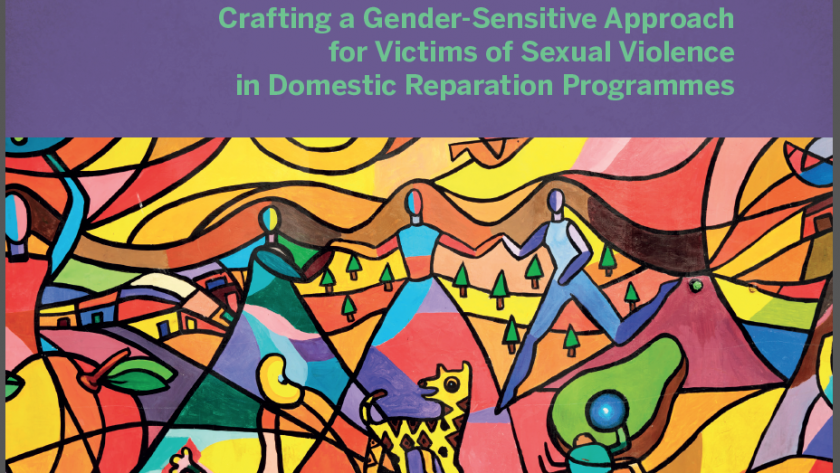Report: Beyond Silence and Stigma – Crafting a Gender-Sensitive Approach for Victims of Sexual Violence in Domestic Reparation Programmes
By Sunneva Gilmore, Julie Guillerot and Clara Sandoval (Reparations Team)

Our new report on reparations for sexual violence and taking a gender-sensitive approach – it is available in English Spanish and French.
Sexual and gender-based violence (SGBV) can cause particular physical, psychological and social harms. Both the human rights violations that cause it, as well as the harms that ensue, require carefully crafted and sensitive reparations that not only aim to alleviate it, but also to reduce stigma and to avoid replicating the structural causes of discrimination and barriers to equality. There has been increasing attention to reparations for SGBV, such as the 2007 Nairobi Declaration, the 2014 UN Secretary General’s Guidance Note on Reparations for Conflict‐Related Sexual Violence, and debates on the role of reparations as transformation. However, while there is some progress as a result of the development of these frameworks in the understanding of how to approach reparation for victims of SGBV, work remains to be done. In particular, greater attention is needed in respect of the implementation and good practices of translating and realising these norms into meaningful remedies for victims of SGBV.
Sexual violence can include rape, sexual slavery, forced abortion, contraceptive control, forced marriage and trafficking for the purposes of sexual exploitation. Gender-based violence is defined by the OHCHR as ‘any harmful act directed against individuals or groups of individuals on the basis of their gender.’ In times of conflict, authoritarianism or political upheaval, while attention is often captured by the perpetration of mass rapes carried out by armed groups, many victims are subjected to sexual violence within their own homes and places of work. These violations also need to be remedied due to the often lack of services or breakdown in law and order during such periods. The Office of the Prosecutor of the International Criminal Court has defined gender-based international crimes as ‘those committed against persons, whether male or female, because of their sex and or socially constructed gender roles. Gender based crimes do not necessarily manifest as a form of sexual violence. They may include non-sexual attacks on women and girls, and men and boys, because of their gender’. While this is a broad concept, it should be emphasised that gender crimes also take place against persons because their gender identity is non-binary. In addition, persons may be targeted due to their sexual orientation when it is perceived as transgressing societal norms around gender and reproduction.
This report recognises that gender-based violence goes beyond sexual violence and must be addressed. However, the focus of this report is on sexual violence as a form and expression of gender-based violence. This is not to undermine other forms of gender-based violence, but to try and make a useful contribution to an area where urgent answers are needed, especially given the complex type of stigma, at individual, family and community level, it produces. Indeed, the stigma that is generated through sexual violence and gender discrimination affects individual development and wider society. For example, those who suffer sexual violence can be perceived in their community as becoming “tainted” and unmarriageable, many of them are unable to provide for and take care of their families affecting parenting, but also broader family ties and life. Besides this impact on the social status of the victims of sexual violence, their economic status can also be affected: stigmatization inside the family and community can lead to the impossibility of accessing means and/or stable income. Furthermore, given the trauma and the physical injuries they suffer, victims may be unable to be economic agents in society and to pursue a life of their choice.
As such, sexual violence (SV), in itself, further marginalises vulnerable groups, depriving them of educational and economic opportunities. This is not to undermine the agency and resilience of victims, many of those we spoke to had not received reparations yet still struggled for redress, but it is to reflect the barriers and compounding harm that sexual violence causes. The report also considers that there is a dearth of significant experience in addressing sexual violence in an adequate manner in Domestic Reparation Programmes (DRPs), an issue that needs to be addressed. DRPs are administrative mechanisms established at the domestic level, often by the executive or parliament, to provide reparation to victims of serious human rights violations and violations of humanitarian law, by providing them access to a remedy through a lower evidential threshold than court claims and with the potential to be, if properly crafted, a more sensitive process to the harms they have suffered.
Sexual violence also deserves special attention, especially since in armed conflicts it can be used as a weapon of war, as well as reflect pre-existing discriminations based on gender and other intersecting vulnerabilities. In this regard, the United Nations has pointed out that, while sexual violence affects both men and women during an armed conflict, women and girls are more likely to be victims of this abuse. However, fewer male victims may be the product of under-reporting. Hidden victimisation and statistics cannot be generalised in all contexts; male sexual violence is unique in its own right in terms of its impact on victims’ masculinity and sexuality. Sexual violence across genders can also occur on a mass scale under authoritarian regimes. We should also be conscious of the impact of historical institutional abuse resulting in mass sexual violence in settled democracies, which may often require transitional justice measures, in particular reparations, to address the multitude of harms. The motivations for and experiences of sexual violence can be different for men and women, for members of the LGBTI community and for those with a different gender identity.



